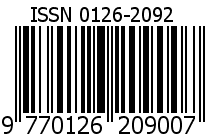SITUASI CAMPAK PADA BALITA (12 -59 Bulan) DI PROPINSI SUMATERA BARAT, DKI JAYA, JAWA BARAT DAN BANTEN) PADA TAHUN 2007 (Analisa Lanjut RISKESDAS 2007)
Abstract
Abstrak
Penyakit campak di Indonesia masih merupakan masalah kesehatan karena diperkirakan 76% orang yang rentan dalam rumah tangga. Insiden kasus pada tahun 2006 golongan umur 12-59 bulan mempati urutan paling pertama yaitu 34,94%. Tujuan dari penelitian untuk melihat gambaran kejadian campak pada empat propinsi ini.
Desain penelitian analisa lanjut RISKESDAS 2007 secara cross-sectional di empat propinsi (Sumatera Barat, DKI Jaya, Jawa Barat dan Banten). Populasi dalam RISKESDAS 2007 adalah seluruh rumah tangga yang terpilih menurut blok Sensus dalam Susenas 2007 yaitu two stage sampling dari tiap kabupaten/kota. Kemudian dari kabupaten/kota diambil secara porposional terhadap jumlah rumah tangga (probability proporsional tosize). Setiap blok Sensus diambil 16 rumah tangga secara acak sederhana (simple random sample). Unit sampel seluruh anggota rumah tangga yang terpilih mempunyai balita (berusia 12-59 bulan) dari proses tersebut diatas dapat digunakan sebagai unit analisis. Penelitian melalui wawancara menggunakan kuesioner. Variabel terikat adalah balita yang menderita campak berdasarkan diagnosa petugas dan berdasarkan informasi gejala dari keluarga dan sebagai variabel bebas adalah jumlah balita, cakupan imunisasi dan cakupan vitamin A.
Hasil penelitian menunjukkan bahwa jumlah kasus berdasarkan diagnosa oleh petugas kesehatan adalah 4,3% di antaranya propinsi DKI Jaya paling banyak (6,9%), sedangkan berdasarkan informasi keluarga dari gejala sebanyak 1,1% di antaranya propinsi Banten paling tinggi (1,8%). Setelah penggabungan jumlah kasus campak menjadi 4,9% diantara propinsi DKI Jaya paling besar (7,5%) dan yang paling rendah propinsi Sumatera Barat (4,1%). Cakupan imunisasi campak sebanyak 65,2% di ataranya propinsi DKI Jaya paling tinggi (71,0%) dan propinsi Banten paling rendah (52,9%).Demikian juga cakupan vitamin A dua kali dalam satu tahun sama (65,2%) di antaranya propinsi Sumatera Barat paling tinggi (79,9%). Odds Ratio (OR) imunisasi 1,6 bermakna (p= 0,001) dan OR pemberian vitamin A adalah 8,3 dan tidak bermakna (p > 0,05). Untuk menurunkan resiko penyakit campak (menurut telaah) maka perlu diberikan vitamin A untuk meningkatkan kekebalan atau antibodi dalam darah, hal ini terlihat di propinsi Sumatera Barat dengan populasi cukup besar serta jumlah kasus paling rendah
ARTIKEL PENELITIAN
19
(4,1%), walaupun cakupan imunisasi rendah (61,0%) sedangkan cakupan vitamin A tinggi (79,9%). Informasi ini bisa sebagai masukan program pemberatasan campak dan perlu ditingkatkan kualitas kerja bidan atau petugas kesehatan atau perlu diamati apakah adanya virulensi vaksin meningkat atau perlu dilakukan iminisasi ulang.
Kata kunci : balita, campak, imunisasi, vitamin A
Abstract
Measles in Indonesia is still become a health problem because it is estimated that 76% of people were vunerable of infection in the household. That case ncident of children aged 12-59 moths to be the first sequence which is 34.94% The aim of the research is to see the picture of measles incidence in four provinces.
The design of this Riskesdas 2007 reseach is cross-sectional study, and was held in four provinces (West Sumatera, DKI Jaya, West Java and Banten). Population in 2007 was Riskesdas all households selected according to the survey, the Census block 2007 is a two stage sampling from each district/city. Then from all the districts were taken by porposional to total households (probability proportional to size). Each block of the Census taken 16 households was randomly (simple random samples). Unit samples all household members who elected to have children (12-59 months old) from the above process can be used as the unit of analysis. Research through interviews using a questionnaire. Dependent variables were the infants who suffer from measles diagnosis based on symptoms of the officers and based on information from family and as an independent variable is the number of children under five, immunization coverage and coverage of vitamin A.
The results showed that the number of cases based on diagnosis by health workers was 4.3% among the provinces of DKI Jaya’s most lots (6.9%), while based on information from the family as much as 1.1% of symptoms among the highest of Banten province (1.8%). After the merger the number of measles cases to 4.9% among the largest province of DKI Jaya (7.5%) and lowest of West Sumatera province (4.1%). Measles immunization coverage as much as 65.2% in DKI Jaya province among the highest (71.0%) and the lowest Banten province (52.9%). Similarly, coverage of vitamine A twice in the same year (65.2%), provinces including West Sumatera the highest (79.9%). Odds ratio (OR) 1.6 immunization was significant (p=0.001) and the OR of vitamin A is 8,3 and not significantly (p>0.05). Followed the risk for measles (under review) it needs to be given vitamin A to increase immunity or antibodies in the blood, it can be seen in the provinces of West Sumatera with a population large enough and the lowest number cases (4.1%)., although low immunization caverage (61.0%) while the high coverage of vitamin A (79.9%). This information can serve as input control programs measles and should be improved quality of midwives or health workers or need to be observed wether the increased virulence of caccines or immunizations repeated as done.
Keywords: children, mesales, immunization, vitamin A





















